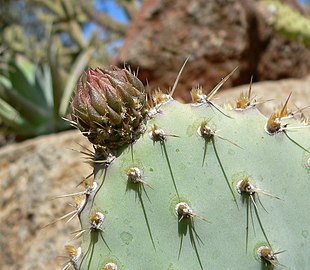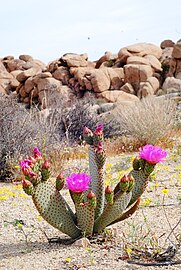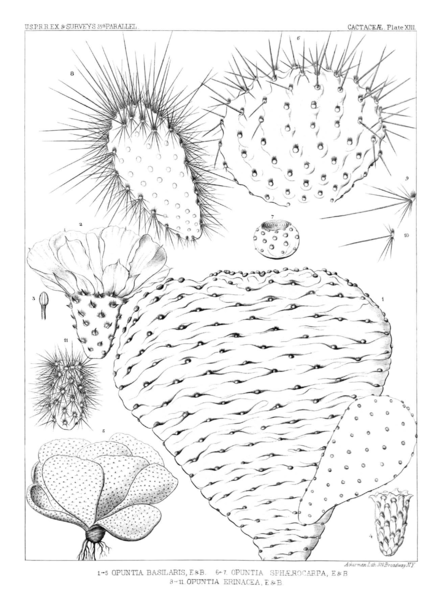| Opuntia basilaris | |
|---|---|

| |
| Conservation status | |
 Least Concern (IUCN 3.1) | |
| Scientific classification | |
| Kingdom: | Plantae |
| Clade: | Tracheophytes |
| Clade: | Angiosperms |
| Clade: | Eudicots |
| Order: | Caryophyllales |
| Family: | Cactaceae |
| Genus: | Opuntia |
| Species: | O. basilaris |
| Binomial name | |
| Opuntia basilaris Engelm. & J.M.Bigelow, 1857 | |
Opuntia basilaris, the beavertail cactus or beavertail pricklypear, is a cactus species found in the southwest United States. It occurs mostly in the Mojave, Anza-Borrego, and Colorado Deserts, as well as in the Colorado Plateau and northwest Mexico. It is also found throughout the Grand Canyon and Colorado River region as well as into southern Utah and Nevada, and in the western Arizona regions along the Lower Colorado River Valley.
Description
Opuntia basilaris is a medium-sized to small prickly pear cactus 70–400 mm (2.8–15.7 in) tall, with pink to rose colored flowers. A single plant may consist of hundreds of fleshy, flattened pads. These are more or less blue-gray, depending on variety, 50–210 mm (2.0–8.3 in) long and less than 100 mm (3.9 in) wide and 10–15 mm (0.4–0.6 in) thick. They are typically spineless, but as is typical for Opuntia species, have many small barbed bristles, called glochids, that easily penetrate the skin. Opuntia basilaris blooms from spring to early summer.
-
 Deep magenta-red filaments and white to pink style
Deep magenta-red filaments and white to pink style
-
 Each areole supports many glochids but are usually without spines.
Each areole supports many glochids but are usually without spines.
-
 Buds, in Joshua Tree National Park
Buds, in Joshua Tree National Park
-
 Flowers, in Joshua Tree National Park
Flowers, in Joshua Tree National Park
Taxonomy

One of the first known descriptions of opuntia basilaris come from the reports of the explorations and surveys for a railroad route from the Mississippi River to the Pacific Ocean. This expedition followed the 35th parallel through New Mexico, Arizona, and California. In the 4th volume of this report, The Botany of the Expedition, by George Engelmann and John M. Bigelow, Opuntia basilaris is described as a stout fan shaped opuntia resembling an open cabbage head, with accompanying illustrations.
Varieties
The species is variable in nature and several names under different ranks have been described. Only four of these are generally accepted.
- Opuntia basilaris var. basilaris (2n=22)
- Opuntia basilaris var. brachyclada (2n=22) – Little beavertail pricklypear
- Opuntia basilaris var. heilii (2n=22) – Heil's beavertail
- Opuntia basilaris var. longiareolata (2n=22) – Elongated beavertail prickly pear or Grand Canyon beavertail pricklypear
- Opuntia basilaris var. treleasei(2n=33) – Trelease's beavertail prickly pear, Bakersfield cactus (This variety is designated as endangered under the federal Endangered Species Act and California Endangered Species Act, which means that killing or possessing it is prohibited in California)
Some experts consider the Trelease's beavertail to be a full species (Bowen 1987, R. van de Hoek). It is unique among the varieties of Opuntia basilaris in that the areoles contain spines in addition to the bristles; this indicates that the species does vary a lot in its exterior.
Distribution and habitat
This species of cactus is found in the Southwest US regions including California, Nevada, Arizona, Utah, and Northwestern Sonora, Mexico. This plant can be found in chaparral, desert, and grassland. This cactus grows in well draining mediums composed of sand, gravel, cobble, or even on boulders.
Chemistry
Opuntia basilaris contains 0.01% mescaline and 4-hydroxy-3-5-dimethoxyphenethylamine.
Uses
The Cahuilla Native Americans used beavertail as a food staple. The buds were cooked or steamed, and then were eaten or stored. The large seeds were ground up to be eaten as mush. The Diegueño would consume it as a dried fruit after removing the thorns. The Shoshone Native American Tribe took advantage of the analgesic properties of this cactus by creating a poultice from the inner mucilage to treat minor cuts.
References
- Pinkava, D.J.; Baker, M.; Puente, R. (2017) . "Opuntia basilaris". IUCN Red List of Threatened Species. 2017: e.T152316A121587572. doi:10.2305/IUCN.UK.2017-3.RLTS.T152316A121587572.en. Retrieved 29 August 2021.
- ^ "Opuntia basilaris". in Jepson Flora Project (eds.) Jepson eFlora. Jepson Herbarium; University of California, Berkeley. 2018. Retrieved 2018-07-06.
- ^ Sullivan, Steven. K. (2018). "Opuntia basilaris". Wildflower Search. Retrieved 2018-07-06.
- "Opuntia basilaris". Opuntia Web. 24 January 2012.
- Engelmann, George; Bigelow, John M. (1856). Pacific Railroad Survey Reports "The Botany of The Expedition". Vol. 4. Washington DC: US Government Printing Office. pp. 43–44.
- Williams, Daniel; Cypher, Ellen; Kelly, Patrick; Miller, Karen; Norvell, Nancy; Phillips, Scott; Johnson, Cheryl; Colliver, Gary (1998). Recovery Plan for Upland Species of the San Joaquin Valley, California. Portland, Oregon: US Fish and Wildlife Service. pp. 49–50.
- Anderson, Edward F. (2001). The Cactus Family. Portland, Oregon: Timber Press Inc. p. 498. ISBN 0-88192-498-9.
- "Plant Chemistry".
- "Temalpakh Ethnobotanical Garden". Malki Museum. Retrieved 2018-07-06.
- Ken, Hedges (1986). Santa Ysabel ethnobotany. San Diego Museum of Man. ISBN 0-937808-42-3. OCLC 1170591869.
- Moerman, Daniel E. (1998). Native American Ethnobotany. Timber Press, Incorporated. p. 365. ISBN 0-88192-453-9.
- Shirazinia, Reza; Rahimi, Vafa Baradaran; Kehkhaie, Ashrafali Rezaie; Sahebkar, Amirhossein; Rakhshandeh, Hassan; Askari, Vahid Reza (2019-03-31). "Opuntia dillenii : A Forgotten Plant with Promising Pharmacological Properties". Journal of Pharmacopuncture. 22 (1): 16–27. doi:10.3831/KPI.2019.22.002. ISSN 2093-6966. PMC 6461298. PMID 30988997. S2CID 115176164.
External links
 Media related to Opuntia basilaris at Wikimedia Commons
Media related to Opuntia basilaris at Wikimedia Commons- Flora of North America; RangeMap
- Arizona Salvage Restricted Protected Native Plants
- Photo gallery
- Opuntia basilaris photo gallery at Opuntia Web
- Malki Museum
| Taxon identifiers | |
|---|---|
| Opuntia basilaris |
|
- IUCN Red List least concern species
- Opuntia
- Cacti of Mexico
- Cacti of the United States
- Flora of the California desert regions
- Flora of the Sonoran Deserts
- Flora of Arizona
- Flora of California
- Flora of Baja California
- Flora of Sonora
- Flora of Utah
- Flora of the Sierra Nevada (United States)
- Natural history of the California chaparral and woodlands
- Natural history of the Central Valley (California)
- Natural history of the Colorado Desert
- Natural history of the Grand Canyon
- Natural history of the Mojave Desert
- Natural history of the Peninsular Ranges
- Natural history of the Transverse Ranges
- North American desert flora